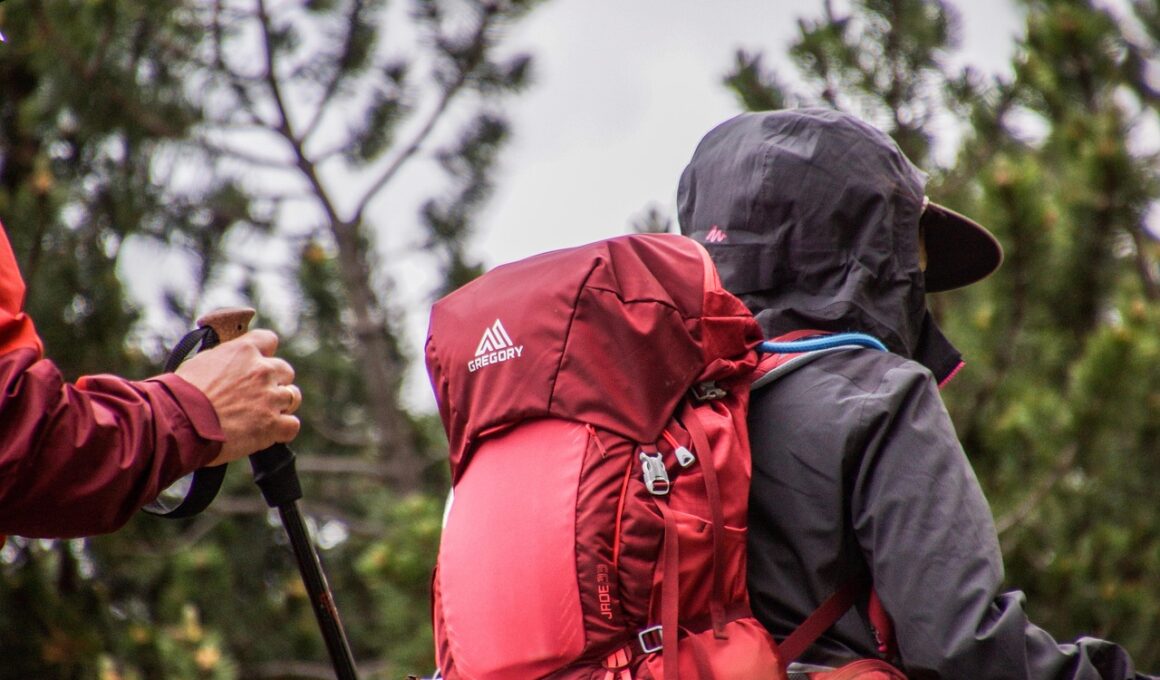Hiking Essentials: Gear and Tips for Fitness Travelers
Hiking is a great way to combine fitness and travel, offering opportunities for exercise while exploring beautiful landscapes. When preparing for a hiking trip, it’s important to invest in proper gear to enhance your experience. Start with sturdy footwear designed for hiking, such as hiking boots or well-cushioned trail shoes. These will provide the necessary support and traction needed for uneven terrain. Next, consider your clothing; opt for moisture-wicking fabrics that keep you dry and comfortable. Layering is key, enabling you to adapt to varying temperatures throughout your hike. Don’t forget a reliable backpack to carry your essentials, ensuring it’s lightweight yet spacious enough to hold necessary items like water and snacks. Hydration is critical; carry a water bottle or hydration reservoir. Additionally, packing a first-aid kit, maps, and multi-tools can be beneficial. Being prepared with essential gear enhances your comfort and enjoyment on the trail, allowing you to focus on the beauty of nature and your fitness goals.
Key Hiking Gear for Safety and Comfort
Safety and comfort are paramount for any hiker, especially those who prioritize fitness during their travels. Always bring a quality first-aid kit which includes band-aids, antiseptic wipes, and pain relievers. Additionally, consider a navigation tool like a GPS device or a map and compass to avoid getting lost. Sun protection is vital, so pack sunscreen, sunglasses, and a wide-brimmed hat to shield against harmful UV rays. If hiking in potentially buggy areas, insect repellent can prevent discomfort and bites. Proper gear is essential, but it’s equally important to know how to use it effectively. Familiarize yourself with your gear before the trip to ensure you can adjust your pack, navigate efficiently, and bandage minor injuries if necessary. Remember to keep your load light; only carry what you need to avoid fatigue. Practicing these precautions will promote a successful, enjoyable hiking experience, allowing you to achieve your fitness goals while enjoying the great outdoors.
Navigating various terrains and climates is a significant part of hiking. One of the top tips for fitness travelers is to choose the right location for your fitness level. Beginners might want to start with well-marked trails featuring minimal elevation changes. Intermediate hikers can tackle moderately challenging terrains with more elevation changes. For advanced fitness travelers, consider trails that demand stamina and endurance, such as mountainous routes or long-distance hikes. Always check weather conditions before heading out, as sudden changes can impact trail conditions significantly. Researching trails online through dedicated hiking sites or apps can provide insights into trail ratings, conditions, and user reviews. Pack accordingly for the conditions you expect and adjust your gear based on changes in the weather. Hydration stations along the trails are valuable, but it’s best to carry sufficient water for your hike. Planning your route and understanding its difficulty will lead to a more enjoyable hike, keeping your fitness goals in sight and reducing possible risks from unsuitable trails.
Staying Fit While Hiking: Tips and Tricks
Maintaining fitness while hiking can be achieved through careful planning and discipline. To keep your energy levels up during long hikes, eat nutritious snacks like nuts, protein bars, and fruits. These provide quick energy and essential nutrients to fuel your body. Timing your meals is also critical; incorporating small snacks while on the move can help maintain energy levels without causing discomfort. During your hike, monitor your physical condition and adjust your pace as needed. Regular breaks allow you to hydrate and refuel, which is important for sustained energy. Integration of strength exercises before your hiking trips can prepare your body for the physical demands of the trail. Exercises targeting the core, legs, and back will enhance your stability and endurance. Incorporating hiking into a broader fitness regimen—like weekly training sessions focused on strength and cardiovascular fitness—will create a solid foundation. Establishing a fitness routine along with hiking will lead you to achieve long-term fitness goals while enjoying every step of your adventure.
After a long hike, proper recovery is essential for fitness travelers. Allow yourself plenty of time to rest and heal from any exertion. Stretching should be part of your post-hike routine, targeting the muscles you utilized while hiking. This will prevent stiffness and ensure flexibility. Hydration continues to be critical, so drinking water immediately after your hike can aid in recovery. In addition to hydration, consider consuming products rich in protein and carbohydrates to replenish energy levels. A balanced meal can also promote recovery; think about a leafy green salad with grilled chicken or a protein-rich smoothie. Furthermore, a hot bath or shower can soothe tired muscles. Prioritize sleep to give your body ample time to repair itself after strenuous activity. Throughout this process, listen to your body. If you feel pain or discomfort that lingers, consulting a professional may be wise. Recovery reflects an essential phase in maintaining your fitness and preparing you for your next hiking experience.
Connecting with Nature: The Mental Benefits of Hiking
Hiking is not solely about physical fitness; it also offers remarkable mental health benefits. Being in nature can boost happiness levels, reduce stress, and increase overall life satisfaction. The serene environment allows for mindfulness, enabling you to focus on the present moment. Observing the beauty of nature can have a calming effect, fought against daily pressures. Moreover, studies have shown that engaging with nature can reduce anxiety and depressive symptoms. Program your hikes to foster a sense of companionship by inviting friends or family to join. Sharing experiences creates lasting memories and encourages social interaction, leading to stronger emotional support networks. This communal aspect enhances the joy of hiking. Make it a practice to disconnect from technology and focus on the sights and sounds around you. Bringing creativity into your hiking trips, such as photography or journaling about your experiences, can also bring additional mental benefits. Overall, combining physical activity with scenic views makes hiking a holistic exercise, benefiting both body and mind while enjoying the wonders of the great outdoors.
To summarize, hiking is a transformational journey that intertwines fitness, adventure, and mental well-being. By properly preparing with the right gear, planning routes matching your fitness level, and utilizing effective recovery strategies, you can maximize your hiking experience. Understanding the essential elements of safe and enjoyable hiking will enrich your travels. Remember that each hike is unique and that listening to your body can lead to a more pleasurable experience. Take time after hikes to reflect on your journey and the beauty you’ve encountered. Aim to introduce the hiking lifestyle as a regular fitness activity, enhancing both physical and mental health. With every step on the trail, you’re not only gaining fitness but connecting deeply with the environment around you. The mountains, forests, and trails beckon, inviting you to embark on new journeys. Embrace the adventure that hiking provides and commit to sustaining an active lifestyle while enjoying every moment. Happy hiking!


